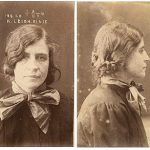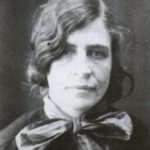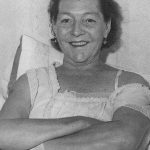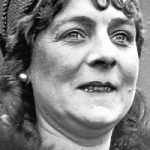Who They Were:
Kate Leigh (1881-1964 107 convictions)
Tilly Devine (1900-1970 204 convictions)
What They Did: The Queens of the Sydney Underworld
- Kate Leigh Mugshot
KATE:
- Kate was born on 10 March 1881 in Dubbo, New South Wales, the eighth child of Roman Catholic parents Timothy Beahan, and his wife Charlotte.
- Her childhood and teenage years included childhood neglect, time in a girls’ home at age 12, and an out-of-wedlock pregnancy; her daughter Eileen May Beahan was born in 1900.
- Leigh married James Ernest ‘Jack’ Leigh in 1902. He was an illegal bookmaker and petty criminal.They separated in 1905 when he was imprisoned for assault and robbery.
- Following his trial, Kate Leigh was convicted of perjury and for being an accomplice to the assault, after being accused of lying under oath to protect her husband; her conviction was overturned on appeal.
- The marriage broke up soon after the trial, though they were not divorced until 1921.
- Kate earned income, variously over these years, as a sly-grog trader (speakeasy/saloon owner), drug dealer, and as a madam.
- She became a major New South Wales (NSW) underworld figure, and has been referred to as its “Queen of the Underworld.”
- From 1919 to 1955 Leigh’s main enterprise was the highly profitable sly-grog trade, which ensued after the NSW State Parliament legislated for six o’clock closing of drinking establishments.
- At its peak, Leigh ran at least twentyish bootleg outlets. Although she made much of her fortune from the illegal sale of alcohol, Leigh is reported to have never drunk (or smoked).
- Leigh also exploited the passage of the Dangerous Drugs Amendment Act 1927 in NSW by providing lucrative illicit criminal distribution networks for the high-demand cocaine it criminalised.
- Leigh derived from her supplies from a corrupt network of doctors, dentists, chemists, and sailors, and amassed considerable wealth from the activity. These activities—the defense of these business turfs—and ongoing feuds with rival organised crime leaders in NSW led Leigh to be a prominent figure in Sydney’s brutal razor gang wars of the 1920s and 1930s.
- The NSW Police also intensively policed incoming vessels for overseas cocaine suppliers in 1938-9, but it was naval transit restrictions associated with the World War II that led to devastating interruptions of Leigh’s overseas cocaine supply.
- Leigh was personally involved in violence, though she was never convicted of any such offense. On 27 March 1930, she shot and killed John William “Snowy” Prendergast when he and other gangsters broke into her home at 104 Riley Street, East Sydney. She was not indicted for the killing, or for shooting Joseph McNamara (in the crotch) nearby in Liverpool St, Darlinghurst on 9 December 1931.
- However, Leigh was imprisoned on drug-related charges. In July 1930, Leigh’s house at 104 Riley Street was raided by a NSW drug squad. Leigh was found in possession of cocaine and was sentenced to 12 months imprisonment.
- Through alleged personal connections throughout officialdom, she continued business throughout the 1930s and 40s despite frequent police raids and a mass of minor convictions.
- She was charged on 107 occasions and was sent to prison on 13 occasions.
- Appearing in courtrooms with flamboyantly expensive clothes and diamonds, her wealth was legendary.
- When appearing in court, Kate would wear diamond rings on every finger of both hands. During her heyday, Kate Leigh owned and operated more than thirty different sly grog hotels at different locations in inner Sydney that generated thousands of pounds in profit annually.
- Leigh was undoubtedly one of Sydney’s wealthiest women during the 1930s and 1940s but the Taxation Department sent her into bankruptcy in 1954 for unpaid income tax and fines dating back to 1942.
- In 1955 the NSW government changed the law to allow legal hotels to serve alcohol until 10 P.M., an act that virtually killed off the Sydney sly-grog trade and put purveyors such as Leigh out of business. Leigh was famously quoted in the Australian media as stating “The bloom has gone off the grog”.
- At the time of her death, aged 83, Kate Leigh was living in virtual poverty in a small room above one of her old illegal hotels. was financially dependent on her nephew, William John Beahan,who ran a mixed business in the shop in the downstairs part of the premises.
- She suffered a severe stroke on 31 January 1964 and was rushed to hospital. She died on 4 February 1964 at St Vincent’s Hospital in Darlinghurst, and her funeral was held on 7 February and was attended by over 700 mourners.
- The press remembered the wily woman not only for her crimes, but for her patriotism and generosity to the poor.
TILLY:
- Matilda Mary Devine born the daughter of bricklayer Edward Twiss, and Alice Twiss in Camberwell, London.
- In 1915, she and many English and Australian women were found working as prostitutes and thieves.
- At 16 she married an Australian serviceman, James (Jim) Edward Devine, on 12 April 1917 at the Sacred Heart Church, Camberwell, London.
- The couple had one son, born at Camberwell in 1919.
- Her career in prostitution began when she was a teenager and continued after she was married.
- She and many English women were usually found soliciting on the wide footpaths on The Strand, at night. From 1915 onwards to 1919, she spent time at Bow Street Court and Lock Up for prostitution, theft and assault.
- When Jim returned to Australia she followed him back on the bride ship Waimana, arriving in Sydney on 13 January 1920.
- Her son stayed in London and was brought up by her parents.
- Both Tilly and Jim Devine rapidly became prominent illegal narcotics dealers, brothel owners and crime gangs members in the Sydney criminal milieu.
- Devine became infamous in Sydney, initially as a prostitute, then later as a brothel madam and organised crime entrepreneur.
- The NSW Vagrancy Act 1905 prohibited men from running brothels; it did nothing to stop women with criminal gangs’ support and bribes to the police from running criminal enterprises.
- Historian Larry Writer has noted that the Devines ran diversified operations. Elite “call girls” were available for politicians, businessmen and overseas guests of significance, while “tenement girls” were young working class women who resorted to casual prostitution to supplement their drug spendings, clothings and meagre earnings during times of Australian criminal and narcotic culture, absence of a comprehensive welfare state and unemployment. Older female prostitutes, “boat girls”, catered to itinerant sailors or working class-men.
- Devine’s wealth was legendary, although it was all earned from crime. She owned much real estate in Sydney, many luxury cars, looted gold and diamond jewellery and travelled by ship in first class staterooms.
- Much of her wealth was also used to pay bribes to the police sectors, and fines for her criminal convictions that spanned fifty years. Devine faced numerous court summons and was convicted on 204 occasions during her long criminal career, and served many jail sentences in the New South Wales jail, mainly for prostitution, violent assault, affray and attempted murder. She was known to the police to be of a violent nature and was known to use firearms.
- Tilly and Jim Devine’s marriage was marred by domestic violence. On 9 January 1931, Jim was charged at Central Police Court with the attempted murder of his wife after a heated argument at their Maroubra home. As Tilly ran out of the house, Jim fired a number of shots at her in a similar way to the murder of George Leonard Gaffney in 1929.
- Tilly escaped unscathed, the only damage being one of her brand new stilettos – the left one. Their terrified neighbours called the police resulting in Jim being arrested and charged over the incident. He was later acquitted, on 16 January 1931, because Tilly refused to testify.
- The Devines separated in the early 1940s and were finally divorced in January 1944.[16] Shortly after Tilly separated from Jim, long time criminal associate, Donald Alexander Kenney, known as ‘Skinny Kenney’, became Tilly’s lover and stand-over man.
- Tilly married for the second time on 19 May 1945 to ex-seaman and returned serviceman Eric John Parsons.
- She famously shot Parsons in the leg after an argument only months before they were married. This shooting occurred at her other Sydney residence: 191 Palmer Street, Darlinghurst. The house was almost opposite the notorious Tradesman’s Arms Hotel. It was at this hotel that Devine met Eric Parsons.
- She was arrested by police and charged with the shooting, but was acquitted at trial. They were happily married for 13 years until Eric Parsons died of cancer on 22 November 1958.
- Tilly was known as one of the most violent criminals in the game. She’d set fire to a policeman, pulled apart a mans face with a razor and generally slashed to ribbons any John who tried to cross her. Bitch. Was. Scary.
- BUT Tilly wasn’t a one trick stab pony, she was a real renaissance woman (be it of the criminal variety) and along with her talent for violence and brothel running, she moved into the illegal booze trade.
- Although Devine was one of Sydney’s wealthiest women in the 1920s, 1930s and 1940s, by 1955, the Taxation Department ordered her to pay more than £20,000 in unpaid income tax and fines sending her close to bankruptcy.
- In 1953 Devine boasted to the media, “I am a lucky, lucky girl. I have more diamonds than the Queen of England’s stowaways – and better ones too!”
- She sold off her last brothel in Palmer Street, Darlinghurst in 1968, and died two years later.
- Devine was famous for flamboyant acts of generosity, and also for her violent feud with criminal vice rival Kate Leigh. Devine was charged by the famous Sydney Detective Frank Farrell on many occasions, and their feud lasted for 30 years.
- Devine had suffered from chronic bronchitis for 20 years, and died of cancer, aged 70 at the Concord Repatriation Hospital in Sydney on 24 November 1970.
- Her funeral service was held at the Sacred Heart Catholic Church, Darlinghurst.
- She was cremated at Botany Crematorium, now known as Eastern Suburbs Memorial Park, on 26 November 1970 with Catholic rites by her married name, Matilda Mary Parsons.
- Her funeral service was poorly attended and her death went virtually unnoticed by Sydney’s media and population and it was said that very few people openly mourned her death. The only public eulogy offered to Devine was given by the then police commissioner Norman Allan who said: “She was a villain, but who am I to judge her?”
THE FEUD:
- Tilly and Kate physically fought one another on numerous occasions and their respective gangs conducted pitched battles in Eaton Avenue and Kellet Street, King’s Cross in May and August 1929.
- Katie and Tilly both operated gangs to mange their businesses and, ‘take care’ of their enemies.
- With both women now firm rivals, their gangs knew their enemy; attacking each other on sight with razors, after Sydney outlawed guns.
- Huge fights of with gang members cutting the living shit out of each other, became a common sight on Sydney’s streets.
- This ceaseless violence became known as: The Razor Gang Wars
- But the violence wasn’t limited to street fights, here are just some of the delightful things Katie and Tilly did to each other:
- Ransacked each other businesses
- Set fire to each other’s businesses
- And ordered rival gang members to be disfigured
- Oh and there was that one time that there was a shoot out at Tilly’s home and her husband shot Kate’s right hand man in the face.
- The war didn’t just play out via stabbings, shootings and slashing. Oh no, Kate and Tilly had one HUGE weapon they liked to break out: PR
- Along with killing and mutalation, Kate and Tilly both used public relations to destroy each other in the papers.
- Kate loved a good bit of PR, you see, she wanted to be seen as Sydney’s Jovial mother figure.
- Sure she might have shot and killed a couple of guys, but really, underneath it all, she was just a nice lady who happened to run a criminal empire.
- In fact it wasn’t even difficult for Katie to become a beloved (if terrifying) criminal.
- While Tilly was famously slashing John’s and dousing policemen in petrol, Kate was making a very public show of donating some of her ill gotten gains to poor children and hosting Christmas for the cities poverty stricken families. .
- In one newspaper write up of Kate’s crimes, the journalist took time to note that the detective followed Kate while she was: ‘Bound on a noble errand of supplying food to unemployed’
- There was no way that Tilly was letting Kate be the public’s favourite and so she went all in, tearing apart her rivals image.
- Tilly played up her English roots in a bid to appear classy, often bought up Kate’s childhood abuse (to try and illustrate how rough Kate was) and of course, Tilly was more than happy to trash her rival to any journalist she could find, saying:
- ‘I’m not like Kate Leigh anyway. I might drink and have a run in with the police now and then, but I don’t take dope, and no one can say I have ruined young girls. Kate Leigh does all this’
- By the early 1930s police were hot on Tilly and Kate’s heels, after yet another series of armed brawls between their gangs had terrorised Sydney.
- As the net closed, Tilly fled home to England for several years; Kate wasn’t so lucky.
- After a series of raids, Kate was arrested, spending the next few years locked up.
- Obviously Kate being Kate, she owned prison; inviting the wardens wife for tea and pretty much ruling over the inmates.
- But when she was released Kate found herself in a very different world, with drugs and illegal boozing now completely off Sydney’s streets.
- Luckily Kate managed to keep her brothel businesses running and therefore could remain one of Sydney’s wealthiest citizens.
- Tilly also landed on her feet, once more back in Sydney and operating her chain of brothels.
- Then in the 1940s Kate and Tilly did the impossible, they called a truce.
- By now all their friends were dead or in jail, both women truly only had each other.
- That didn’t stop them from continuing to constantly tear each other a new one in the press.

Ruth Coker Burks
Who was she: the Cemetery Angel
Dates: 1958/1959-Present
- NEW YORK, NY – JUNE 20: Ruth Coker Burks attends 6th Annual Broadway Sings For Pride Concert at JCC Manhattan on June 20, 2016 in New York City. (Photo by Laura Cavanaugh/FilmMagic)
- 25-year-old Ruth had been spending a lot of time at the local hospital visiting
her friend who was fighting cancer. As like every visit before, she passed a door covered in a red bag that read “Don’t Enter. G.R.I.D” or Gay-Related Immune Deficiency. - The door was never opened, and even the nurses seemed afraid to enter.I t was 1984 in the heat of the AIDS crisis. There was a lot misinformation, fear, and homophobia surrounding this mysterious illness that was rapidly taking the lives of more and more young, otherwise healthy gay men.
- Ruth, who had a gay cousin, was curious about the illness and the patient on the other side of the red door.
- She asked the nurses, whom she had gotten to know well over her many visits, about the patient. They warned her, “Don’t you dare go in that room, he’s got the gay disease. We don’t even know what it is. Don’t you go in there.”
- At the time, no one knew how AIDS spread which is probably why the nurses wouldn’t bring the patient’s food into this room. Ruth could see trays of food piled up outside of the man’s door, trays he was too weak to retrieve, and she could see the nurses drawing straws to see who would have to go in and check on him.
- Ruth recalled that she wasn’t sure what made her enter the room. Maybe it was her maternal instincts as a young mother or perhaps it was curiosity. Whatever it was, Ruth felt compelled to see the patient everyone was so terrified of.
- Lying in the bed was a man named Jimmy and it was clear that he was dying. Ruth asked Jimmy if there was anything she could do for him to which Jimmy asked for his mama.
- Ruth walked to the nurses and asked if they could call Jimmy’s mother. They replied, “That man’s mother’s not coming. He’s been here six weeks. Nobody is coming.” Though they weren’t hopeful, the nurses gave Ruth the mother’s phone number anyway.
- When Ruth called, Jimmy’s mother first hung up.
- Well, no one hangs up on Ruth Coker Burks, so she called back and said “If you hang up on me again, I will put your son’s obituary in your hometown newspaper and I will list his cause of death.”
- This caught the woman’s attention long enough for her to say “I don’t have a son. My son died years ago to me. He was a sinner. I don’t know the man who’s there but when he dies, don’t call me back.”
- The nurses wouldn’t help. The mother wouldn’t help. So Ruth did the only thing she could. She went back into Jimmy’s room, not knowing what she was going to say.
But when Ruth took Jimmy’s hand, he looked at her and said, “Oh mama, I knew you’d come.” - Ruth recalled that Jimmy started sobbing, but he was so dehydrated, he couldn’t even produce tears. Ruth stayed with Jimmy for 13 hours until he finally passed away.
- A little more backstory, Ruth was born in Hot Springs, Arkansas in 1958/1958, as Frances Ruth Coker Burks after her grandmother.
- As a child, Ruth’s mother was under long-term hospitalization for tuberculosis and Ruth’s father acted as her primary caregiver until he died when Ruth was 5.
- This left Ruth’s mother struggling to be a parent while managing her illness.
- Ruth credits this too-tragic-for-Disney childhood for giving her an incredible sense of empathy.
- For generations, members of Ruth’s family had been buried in Files Cemetery, dating all the way back to the 19th century.
- Ruth’s mother had a plot in the same row as her brother (Ruth’s uncle.) However, the two got into an argument and Ruth’s mother bought 262 grave spaces to ensure the uncle and his extended family couldn’t be buried with the rest of the family. Those 262 plots were left to Ruth and she had no fucking idea what she would ever do with them.
- It took a lot of phone calls before Ruth was able to find a funeral home that would take Jimmy’s body.
- When she did finally find one, WHICH WAS 70 MILES AWAY, they said they would only cremate him.
- They sent Jimmy’s ashes back in a cardboard box. Ruth had to use a cookie jar for an urn. Then, no cemetery would take him.
- Ruth used one of the 262 plots and buried Jimmy. She couldn’t find anyone who would dig the hole or anyone to say a prayer, so Ruth took her daughter, who was so little she still had a binky, and dug the grave herself and said a prayer.
- Fearing townspeople would deface the grave, she buried Jimmy on top of her father’s grave.
- This may have been a one off act of extreme kindness, but word got around about Ruth’s deed. Then the phone calls started.
- Ruth began getting calls from others suffering from AIDS who needed help. Ruth recalled, “Word got out that there was this kind of wacko woman in Hot Springs who wasn’t afraid. They would tell them, ‘Just go to her. Don’t come to me. Here’s the name and number. Go.’ I was there hospice. Their gay friends were their hospice. There companions were their hospice.”
- Referrals came in from all over, including rural hospitals all over Arkansas. Ruth began taking patients to appointments, helping them get financial assistance when they could no longer work, helped them get access to medications, and provided general emotional support.
- Getting medicine for patients was particularly difficult since a lot of pharmacies flat out refused to carry them.
- When her patients died, they would leave Ruth their unused medications. Ruth would stockpile these meds to use for patients who couldn’t get access.
- As a Real Estate Agent, Ruth couldn’t finance everything herself and relied on donations. She partnered with drag clubs and gay bars to host fundraisers to raise money.
- Ruth said, “They would twirl up a drag show on Saturday night and here’d come the money. That’s how we’d buy medicine, that’s how we’d pay rent. If it hadn’t been for the drag queens, I don’t know what we would have done.”
- When her patients would die, Ruth would always contact their families to try and get them to claim their bodies. They were rarely compassionate and would even pray at her. Yes. AT her. Ruth continued burying her patients on her family’s plot. She would bury them over existing graves, again to discourage vandalism. When her daughter was old enough, she would help Ruth, carrying her own spade while Ruth would carry a post digger.
- Of the thousands of patients Ruth cared for, she buried just over 40 on her family’s plot. Because of the care and support Ruth provided, her patients lived longer than the national average life expectancy. This caught the attention of a little organization called the Centers for Disease Control and Prevention who sent researchers to investigate.
- During Bill Clinton’s presidency, Ruth worked as a consultant for AIDS education!
- So, what did Ruth get for all of her incredible work?
- Her community and church shunned her. When she tried to tell people what was happen to try and raise the alarm, they wanted no part of it. One prominent doctor told her, “I will tell you here and now, I will never have an AIDS patient in my office.”
- Ruth was on the finance committee of her church and asked if she could use one of the Sunday school classrooms at the church for support meetings once a month. The minister of the church said, in front of everyone, “Surely, you aren’t talking about bringing THOSE people into this church are you?”
- Ruth collected herself and responded like a lady, saying “Oh no. I’m not talking about bringing THOSE people into this church. Instead, I’d like to walk THOSE people across your new $30,000 lawn and into your new $300,000 home, and sit their asses on the $40,000 dollars-worth of new furniture this church just bought you! That’s what I’d like to do with THOSE people.”
- When the medical community began pulling their heads out of their asses and attitudes towards AIDS began improving, Ruth worked as a fishing guide and funeral director in Florida.
- In 2012, Ruth suffered a stroke and had to relearn how to talk, read, feed herself, write, and do other everyday task. She believes the stress from caring for AIDS patients contributed to the stroke.
- She moved back to Arkansas to be closer to her family and also because her health insurance dropped her after her stroke.
- In 2013, she heard about 3 foster children who were removed from school due to rumors that one might be HIV-positive. I imagine, like an old grizzled cop, she said “I’m getting too old for this shit,” before she began advocating for the kids. She appeared on TV as an HIV advocate.
- Naturally, her community shunned her and the funeral home she had worked at, who basically said when you’re better you can come back, rescinded their job offer. Also, no one else would hire her.
- A local Walmart allegedly destroyed a chair she had sat in there after finding out about her HIV advocacy. Remember. This is 2013.
- In 2016, Ruth along with other HIV/AIDS advocates were honored at New York City’s Pride Week by non-profit group Broadway Sings for Pride.
- Ruth is also working on creating a memorial for AIDS victims and turning Files Cemetery into a garden.
LEGACY
- Jimmy’s story and those of the thousands of people Ruth helped were not unique. Imagine all of the people who didn’t have anyone to claim and bury their bodies.
- While HIV/AIDS is no longer a death sentence like it used to be, it’s still a serious issue that affects a disproportionate number of black, Latino, and LGBTQ+ community members.
- According to the Kaiser Family Foundation, 15% of people infected with HIV don’t know it which is why it’s important to use protection and get tested every 3 months if you’re sexually active.
- As for Ruth? She’s currently working on a memoir of her story and working on a film based on her life and book.
- In 2017, Rose McGowan wrote and directed an unauthorized short film titled Ruth inspired by Ruth’s work.
- She still cares for the graves in her family plot and advocates for better care for HIV/AIDS patients. The cemetery has become a pilgrimage site for those affected by the crisis and a place for them to remember those they lost and say good bye, even if they aren’t buried there.





